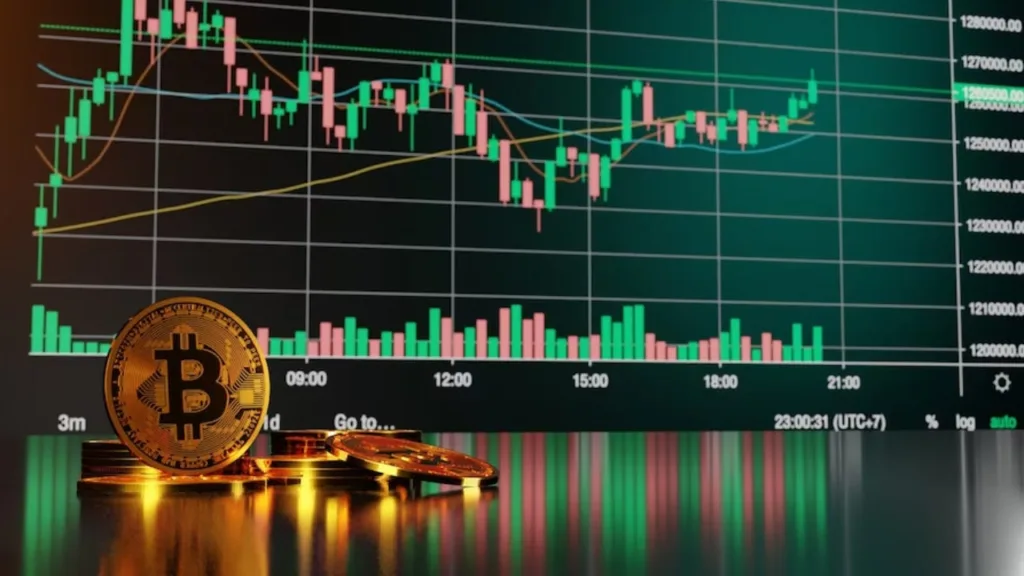Understanding Bitcoin Volatility: Bitcoin, the flagship cryptocurrency, has long been known for its wild price swings and volatile nature. Investors and enthusiasts alike watch its every move, eager to catch the next big wave. But recently, something unusual happened. Before the sharp price decline on June 7, Bitcoin’s volatility over the previous 15 days was remarkably low, falling within the bottom 6% of occurrences in its entire history. This period between May 24 and June 7 marked a significant calm before the storm, and it’s worth delving into what this means for Bitcoin and its investors.
Understanding Bitcoin Volatility
To grasp the importance of this low volatility period, we first need to understand what volatility means. In financial terms, volatility refers to the degree of variation of a trading price series over time. It’s often measured by the standard deviation of returns. For Bitcoin, known for its rapid and unpredictable price changes, volatility has been a hallmark since its inception.
Historically, Bitcoin’s volatility has been driven by various factors, including market sentiment, regulatory news, technological advancements, and broader economic conditions. Its price can soar or plummet in response to a tweet, a new piece of legislation, or a hack of a major exchange. Therefore, a period of low volatility is noteworthy.
Recent Trends in Bitcoin Volatility

In the lead-up to June 7, Bitcoin’s price movement was minimal. Swan Bitcoin’s Chief Investment Officer, Rapha Zagury, highlighted this unusual calm, noting that the 15-day rolling volatility was at 23%. This figure placed it within the bottom 6% of all such periods historically. In other words, Bitcoin’s price moved so little that it was reminiscent of some of the least volatile periods in its history.
Factors Influencing Bitcoin Volatility
Market Sentiment
Market sentiment plays a crucial role in Bitcoin’s volatility. Positive news can drive prices up, while negative news can cause them to plummet. When sentiment is stable, volatility tends to be lower.
Regulatory News

Announcements from governments and regulatory bodies can significantly impact Bitcoin’s price. Clear regulations can boost confidence and reduce volatility, while uncertainty or negative regulations can increase it.
Technological Developments
Advancements in Bitcoin’s underlying technology, such as upgrades to the Bitcoin protocol or the development of new financial products like ETFs, can influence its price stability.
Macroeconomic Factors
Broader economic conditions, such as inflation rates, interest rates, and economic growth, also play a part. For instance, Bitcoin is often seen as a hedge against inflation, so economic policies affecting inflation can impact its price.
The Significance of Low Volatility
Low volatility in Bitcoin is a double-edged sword. On one hand, it signifies a period of stability, which can be reassuring for investors and may attract more institutional participation. On the other hand, it can also indicate a lack of significant trading activity, which might precede a major price movement, as was the case on June 7.
Detailed Analysis of the May 24 to June 7 Period
During the period from May 24 to June 7, Bitcoin’s volatility was notably low. Rapha Zagury’s insights point to this period as being exceptionally calm, with the 15-day rolling volatility sitting at just 23%. This number is striking because it places the period within the bottom 6% of all historical 15-day volatility measures for Bitcoin. This unusual calm was eventually disrupted by a sharp price decline on June 7.
Comparative Analysis with Other Periods
When comparing this recent low volatility period to others in Bitcoin’s history, it’s clear that such periods are rare. Previous instances of low volatility often preceded significant market movements. For example, low volatility was observed before major bull runs in the past. However, it’s also been seen before sharp declines, making it a period of uncertainty for investors.
Potential Reasons for Recent Low Volatility

Market Maturity
As the Bitcoin market matures, it’s possible that volatility naturally decreases. More sophisticated trading strategies and a larger market cap can contribute to more stable prices.
Institutional Adoption
The increasing involvement of institutional investors could be another factor. These entities typically trade in larger volumes and can stabilize prices through their market-making activities.
External Economic Conditions
Global economic stability during this period might have contributed to lower volatility. With fewer economic shocks, Bitcoin prices remained more stable.
Implications for Traders and Investors
For traders, low volatility periods can be challenging. The lack of significant price movement means fewer opportunities for short-term gains. However, for long-term investors, such periods can be an opportunity to buy Bitcoin at stable prices and hold it for future appreciation.
Strategies for Understanding Bitcoin Volatility
Investors might consider strategies such as dollar-cost averaging, which involves buying a fixed amount of Bitcoin at regular intervals regardless of the price. This approach can reduce the impact of volatility on the overall investment.
Long-Term Investment Outlook
Low volatility periods can be a good time for long-term investors to accumulate Bitcoin. The stability can be seen as a sign of a maturing market, potentially leading to future price increases as adoption grows.
Predictions for Future Volatility
Expert Opinions
Experts are divided on whether Bitcoin’s volatility will increase or decrease in the future. Some believe that as the market matures, Understanding Bitcoin Volatility will naturally decline. Others argue that Bitcoin will always be volatile due to its speculative nature.
Possible Scenarios
If Bitcoin continues to gain mainstream acceptance, we might see a gradual decrease in volatility. Conversely, if new regulations or technological disruptions occur, volatility could spike again.
The June 7 Price Decline
The sudden price decline on June 7 serves as a reminder of Bitcoin’s unpredictable nature. While the exact causes are often complex and multifaceted, factors such as market manipulation, large sell-offs by whales, or sudden changes in market sentiment can trigger such moves.
Causes of the Price Drop
Possible causes for the June 7 drop include profit-taking by large investors, negative news, or a technical correction after a period of stability.
Immediate Market Reaction
The market’s reaction to the price drop was swift, with trading volumes spiking as investors rushed to buy the dip or cut their losses. This reaction highlights the underlying volatility that can resurface at any moment.
Impact on the Cryptocurrency Market
The impact of Bitcoin’s price movements on the broader cryptocurrency market is significant. When Bitcoin experiences a sharp decline, altcoins often follow suit, demonstrating the interconnected nature of the market.
Effect on Altcoins
Altcoins, which tend to be even more volatile than Bitcoin, often experience greater price swings in response to Bitcoin’s movements. A drop in Bitcoin can lead to even sharper declines in altcoins.
Broader Market Sentiment
Bitcoin’s volatility influences the sentiment of the entire cryptocurrency market. A stable Bitcoin can boost confidence across the market, while volatility can lead to widespread uncertainty and fear.
How to Navigate Low Volatility as an Investor
Navigating periods of low volatility requires a strategic approach. Investors should focus on long-term goals and avoid making impulsive decisions based on short-term price movements.
Investment Tips
- Diversify Your Portfolio: Don’t put all your eggs in one basket. Diversifying can reduce risk.
- Stay Informed: Keep up with the latest news and developments in the crypto space.
- Set Clear Goals: Have a clear investment strategy and stick to it.
Risk Management Strategies
- Use Stop-Loss Orders: Protect your investments by setting stop-loss orders to limit potential losses.
- Avoid Over-Leveraging: Using too much leverage can amplify losses during volatile periods.
- Regularly Review Your Portfolio: Periodically reassess your investments to ensure they align with your goals and risk tolerance.
Conclusion on Understanding Bitcoin Volatility
Bitcoin’s recent period of low volatility is a fascinating development in the world of cryptocurrencies. While it signifies a level of stability, it also serves as a reminder that the market can shift rapidly. Understanding the factors that influence Bitcoin’s volatility and knowing how to navigate these periods can help investors make informed decisions. As the market continues to evolve, staying informed and adapting to changing conditions will be key to success in the world of Bitcoin investing.
FAQs on Understanding Bitcoin Volatility
Why is Bitcoin volatility significant? Bitcoin volatility is significant because it impacts trading strategies, investor sentiment, and the overall stability of the cryptocurrency market.
How does low volatility affect trading? Low volatility can limit short-term trading opportunities but may offer a more stable environment for long-term investments.
What are the main factors influencing Bitcoin’s price? Key factors include market sentiment, regulatory news, technological developments, and macroeconomic conditions.
How should investors respond to low volatility? Investors can adopt strategies like dollar-cost averaging, focus on long-term goals, and use risk management tools like stop-loss orders.
What can we expect from Bitcoin’s volatility in the future? Future volatility will depend on market maturity, institutional adoption, regulatory developments, and global economic conditions.
For more info visit Ecrox Coin and also check out Ecrox Launchpad.


